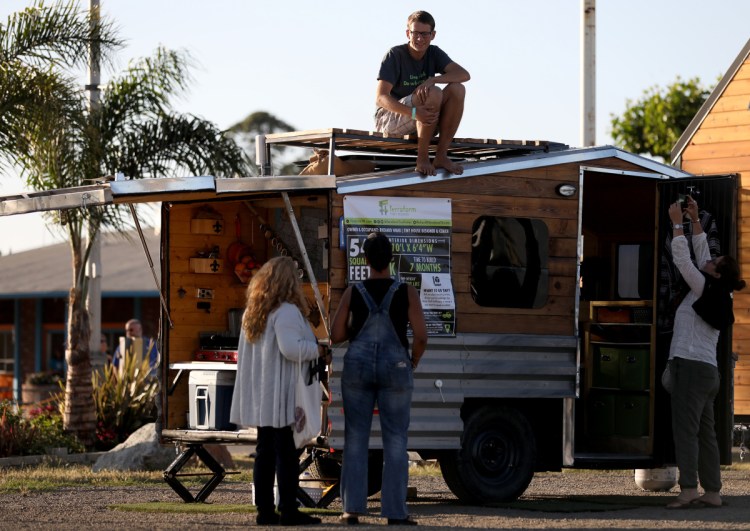It’s 2018 and the American Dream looks slightly different. The big house has been replaced with a … tiny house. The white picket fence is now four wheels. The 2.5 kids are missing and the dog … OK, the dog is still there and he’s probably living a better life than you.
A vision of this new and ever-dynamic dream was on display at the Santa Clara County, Calif., Fairgrounds last weekend at TinyFest, a showcase of more than two dozen different types of small homes that offer an alternative to traditional housing. Here, a shipping container that once carried cargo has been retrofitted into a home complete with a shower-equipped bathroom, bedroom and large windows; a 1986 green school bus that used to carry children now comes stocked with benches, a bed, TV, composting toilet and a kitchen. Oh, and it all runs on vegetable oil.
On a recent trip from Idaho through Yellowstone National Park and on to Minnesota, the owner of the bus, 30-year-old Kyle Volkman, paid just $15 in diesel fuel.
It’s little wonder why young and old alike were waiting to get inside the fairgrounds well before the weekend-long event opened.
In the housing-depleted market of Silicon Valley, the virtues of the emerging social movement speak to the average Bay Area resident who has environmental concerns, financial concerns, and the desire for more time and freedom on their mind.
Jae Duvall, who runs a family landscape business, was there to get some ideas for her near future. She wants to trade in her studio apartment in East San Jose, a city she’s called home her whole life, for a tiny home elsewhere.
Though she doesn’t know what kind she likes just yet, she knows she wants her tiny home to have a spacious bathroom and kitchen. She said she can see herself living this new, off-the-grid life in a town close to the Sierra Foothills.
“I can’t afford to buy a house on my own in this Valley,” the 65-year-old said matter-of-factly. “I’d like to retire here, but I can’t because of the prices. I’ll probably have to leave.”
At half Duvall’s age and with a data analyst job at Google, Daricus Releford doesn’t worry as much about finances as he does about practicality.
Just because he can afford to, he said he doesn’t want a significant portion of his paychecks going toward the $2,600 in rent he pays for the 700-square-feet, one-bedroom San Jose apartment he shares with his girlfriend, Yanin Rosario, a receptionist at Google. And he isn’t alone; Releford said he knows of colleagues that make $150,000 but choose to live in RVs.
“A lot of people at Google, they’re really practical,” the 30-year-old said. “We have friends that work there that make half a million dollars. Even though we do make decent money I suppose in the Bay Area, we’re also about practicality.”
As he and Rosario toured the various homes to find one they like, they appeared drawn to the shipping container home. The idea, they said, is to buy one and rent it out for some time and maybe move into it someday. Downsizing, an issue that many contend with when they transition into the lifestyle, isn’t much of a concern for him, Releford said.
“We’re already in a compact space in the Bay Area anyway,” he said.
Next to the very contemporary-looking shipping container that Releford and Rosario were eyeing stood a gingerbread house fit for Hansel and Gretel. It drew marveling from afar, curious peeks from up-close and served as a photo-op for delighted attendees. Miguel Elliott, the maker of the hut, enthusiastically explained to anyone within earshot the distinctive features of his fairy tale-inspired tiny home.
“It’s made out of recycled pallets, insulated with straw, and covered in an Earthen plaster,” he said. “This is all locally sourced and almost no-cost housing.”
Elliott said he normally keeps the hut on his farm in Sebastopol and that it is one of five he’s made so far as part of his business, Living Earth Structures. The others can be found in and out of the Bay Area, including Oakland and Petaluma. Eventually he’d like to build whole villages of tiny gingerbread homes for the homeless. And in the spirit of “teaching a man to fish,” he said he’d like to get the homeless involved in building them, too.
“First of all, communal living is so healing for an individual,” he said. “Most homeless people have been so isolated and haven’t felt the support of people. The model is they’d be helping each other build their houses.”
Hector Guerra, 69, is an Army veteran who lives in a five-bedroom house with four other veterans in San Jose.
Guerra also helps to place veterans in housing through his work with the Homeless Veterans Emergency Housing Facility. He said he was there to get ideas for 130 homeless vets he’s working with.
Send questions/comments to the editors.



Comments are no longer available on this story